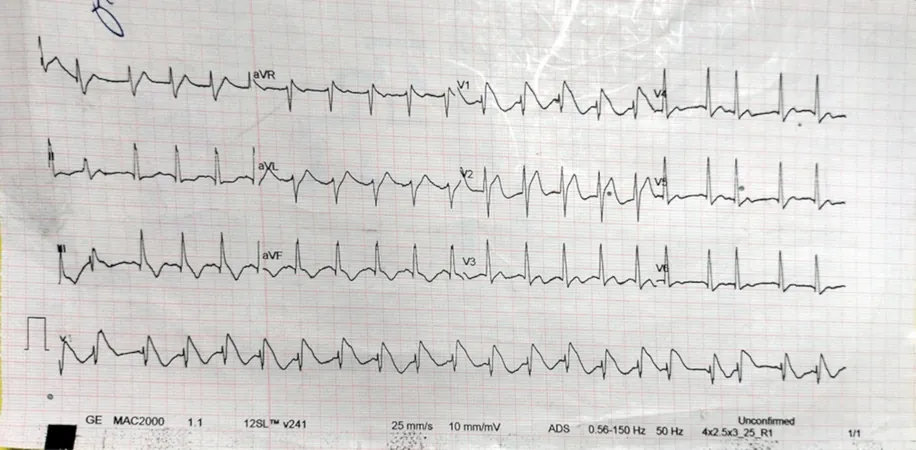
The Hidden Threat of Aluminum Phosphide Poisoning: A Case Study That Will Leave You Speechless!
2025-05-11
Author: Daniel
The Deadly Dangers of Aluminum Phosphide Poisoning
Aluminum phosphide (AlP) poisoning stands out as one of the leading causes of poisoning-related fatalities worldwide, especially in agricultural hotspots like Egypt. Initial symptoms often include debilitating nausea, relentless vomiting, and severe abdominal pain. These vague presentations, combined with the swift progression of the illness, pose a significant challenge for medical professionals.
A Race Against Time: Treating AlP Poisoning
The management of AlP poisoning typically involves conservative measures such as gastric lavage and symptomatic treatment with vasopressors. Alarmingly, mortality rates can soar as high as 100%, with many victims succumbing within just 24 hours. Cardiovascular complications, ranging from fatal arrhythmias to heart failure, are tragically common among affected individuals.
The Silent Barrier: Patient Non-Disclosure
Patient non-disclosure further complicates an already dire situation, leading to broader differential diagnoses that can hinder timely intervention. A revealing survey found that over 12% of respondents chose to withhold medical information from healthcare providers, often due to privacy concerns or misunderstandings.
A Case Study That Shocks!
Consider the case of a 19-year-old male who arrived at the emergency department with severe vomiting and epigastric pain, yet vehemently denied any exposure to toxic substances. His vital signs indicated profound hypotension, and tests revealed potentially deadly metabolic acidosis and cardiac biomarkers sky-high.
The Unfolding Mystery: Diagnosis Under Duress
Despite aggressive treatment efforts, including intravenous fluids and vasopressors, his condition worsened. Only on the third day did he finally confess to ingesting an expired aluminum phosphide pellet—a revelation that came too late. The patient soon fell into shock and cardiac arrest, succumbing to the poisoning's wrath after just minutes of life support.
The ECG Enigma: Brugada Pattern Revelation
This distressing case displayed an unusual Brugada ECG pattern, typically mistaken for acute coronary syndrome. While some previous studies reported similar finds, they often showed negative troponin results—this case diverged sharply, reflected in the elevated cardiac enzymes indicating extensive myocardial damage due to phosphine gas.
Complex Lab Results Point to Severe Toxicity
Significant lab findings, including liver dysfunction and coagulation abnormalities, signify multi-organ involvement characteristic of AlP toxicity. The disruption of mitochondrial function leads to cellular damage, particularly affecting the heart and liver. Blood sugar levels spiked dangerously high, underscoring the potential complications that can arise from AlP poisoning.
Urgent Awareness Needed!
This heartbreaking case exposes the essential need for clinicians to maintain a high degree of suspicion for Aluminum phosphide poisoning, especially in rural areas where the substance is easily accessible. Early recognition and empathetic communication with patients can make the difference between life and death.
Conclusion: A Call to Action Against a Silent Killer
Aluminum phosphide poisoning remains a dire toxicological threat, requiring swift action and heightened awareness. The grim outcome of this case emphasizes the importance of obtaining a comprehensive history from patients, facilitating timely interventions, and monitoring critical lab values to improve prognosis.
As we continue to face the challenges posed by such toxic substances, let this case serve as a crucial reminder: understanding and addressing the complexities of poisonings like AlP could save lives.



 Brasil (PT)
Brasil (PT)
 Canada (EN)
Canada (EN)
 Chile (ES)
Chile (ES)
 Česko (CS)
Česko (CS)
 대한민국 (KO)
대한민국 (KO)
 España (ES)
España (ES)
 France (FR)
France (FR)
 Hong Kong (EN)
Hong Kong (EN)
 Italia (IT)
Italia (IT)
 日本 (JA)
日本 (JA)
 Magyarország (HU)
Magyarország (HU)
 Norge (NO)
Norge (NO)
 Polska (PL)
Polska (PL)
 Schweiz (DE)
Schweiz (DE)
 Singapore (EN)
Singapore (EN)
 Sverige (SV)
Sverige (SV)
 Suomi (FI)
Suomi (FI)
 Türkiye (TR)
Türkiye (TR)
 الإمارات العربية المتحدة (AR)
الإمارات العربية المتحدة (AR)